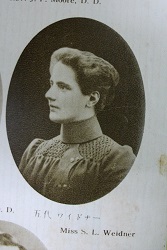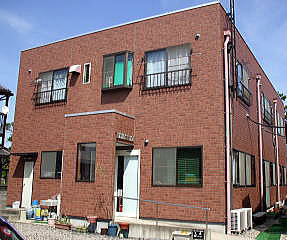
Life story of Sadie Lea Weidner
Sadie Lea Weidner, A missionary who loved Japan and devoted her life to Christian service there.
Prayers in her infancy

Sadie was born in Ohio, U.S.A. in 1875. As she was bereaved of her parents in her infancy, she and her younger sister were taken into the custody of their eldest sister. Their sister who took the role of their mother was a remarkably beautiful, brilliant and faithful woman and many wealthy men and scholars had repeatedly proposed to her. But declining them all, she had married a plain pastor who had dedicated his life to serving the Lord Jesus Christ, his Savior with all his heart and soul .
Their humble life was sufficient only for daily meals. But every Saturday her eldest sister washed and pressed their only change of clothes so they could wear their best clothes to the church on Sunday.
As from her early age, she listened to the Bible story every day, and she was taught to pray. She had a firm faith since she was young.
One night when she was 11, her eldest sister told Sadie about "a country called Japan" and prayed at their prayer time.
"In an island country called Japan in the east, poor families have to sell their girls for their livelihood". Her heart was broken for those girls and she prayed in tears to the Lord to send her to Japan to tell the people in misery the love and salvation of God.
Her decision of that night had marked her school days and her entire life. She had studied so hard that when graduating from her eight-year Baltimore Elementary School in Ohio in 1889, she was entitled to enter any high school in Ohio with a scholarship and without any entrance examination. She studied at Mount Eaton and Bellevue four-year high schools, and obtained a certificate as an elementary school teacher.
She studied at Heidelberg University in Tiffin, Ohio for a year and half and took a one-term session at the Moody Bible Institute.
Then she taught in an elementary school for five years.
Calling to japan

Sadie came to Japan for the first time in June 1900 at 25 years of age.
She was first assigned in Sendai City, Miyagi Prefecture, as a school teacher and missionary and appointed to the interim principal of Miyagi Girls' School. (Currently Miyagi Gakuin Women's University.)
In September 1902 she was then assigned as a professor and also she resumed mission activity.
In January 1907 she returned to USA for a short break and visited local churches to introduce and ask for support of Miyagi Girls' School and the mission activity. From January to June in 1909 she took courses of language, school system, and school administration law at Columbia University in New York.
In August 1909 she was assigned as the principal of Miyagi Girls' School by the North America Reformed Church overseas mission committee and returned to Japan.
In February 1910 she became the official founder of the school.
As a missionary she had raised hundreds of Bible women, dedicated Christians, in the school, but gradually liberal missionaries with modernistic leanings had increased so many in the school, she decided she could not work with them for her stand of faithfully obeying the Words of God.
Though she was nominated an honorary member for the Miyagi education board in May 1913, she resigned the school and returned to the U.S.A. in June 1913. Her resignation was regretted by her many friends and associates in the political, business and education circles.
Sadie then spent five years in America, studying at Dr. White's Bible University and presented the mission work in Japan at various districts.
In 1918 she returned to Japan this time as an independent missionary. Even today we see few independent missionaries. It was an unbelievable act to go to a foreign country on one's own without support from a home mission.
"Where the Lord leads, He surely provides." Sadie Weidner had an absolute trust in The Almighty God. She loved Japanese people and had bravely chosen her way though it meant the risking of her life at a difficult time in Japan.
She went to see prominent Christian leaders in Tokyo and asked them "Where is the most difficult place for a mission work in Japan?". They said "It is the Seino district in Gifu Prefecture."
"Gifu Prefecture area used to be called a Buddhist kingdom since a long time ago and the region is still suffering from the damage by a great earthquake in 1891 and we hear that poor farmers are selling their girls to make a living. Many pastors had been sent there, but all failed and came back without fruit." But when she heard it, she was instantly convinced that it was the place the Lord was leading her. Her young days' prayer was answered. Though some tried to stop her and said "Miss Weidner, you cannot stay in Ogaki, it is 25 years behind Sendai".
When she left for Japan, she was given Isaiah 50:7.
"For the Lord God will help me, therefore shall I not be confounded: therefore have I set my face like a flint, and I know that I shall not be ashamed." Trusting this verse, she moved to Ogaki. It was November 1918.
What was waiting for her there was severe hostility against Christianity and foreigners. She had to start first with Sunday schools, and then she started a kindergarten the following May.
Soon she could rent an old Feudal lord's house in the center of Ogaki, which was large enough to house the church, Bible school, the kindergarten with 80 kids, a dormitory for Bible school students, and living quarters for missionaries.
Sadie named the mission "Seino( western Mino) Mission" so people would not call it Miss Weidner's Mission. Later the name was changed to "Mino Mission", when the faith work had covered most of the Mino region.
Standing for the Lord
Sadie had earnestly spread the Gospel, way of salvation by the Lord Jesus Christ, not only in the church but sent faithful workers to obscure areas and also held Gospel tent meetings at many places.
She distributed Gospel tracts from door to door. She hung big signs with Scriptures from the Bible at railroad stations and streets where many people passed by. Many people who had been disappointed in life or under heavy burdens came to church one after another, seeking for salvation. And the mission stations and church buildings increased in the Mino region.
She had been widely known in the education board and political society, and many prominent scholars and Christian leaders came to see her in Ogaki, to keep up their friendship.
Sadie had absolute faith in our Creator, the true living God. She always prayed first before carrying out her faith work.
In those days trains and bicycles were considered to be the convenient transportation, but she had American cars and a Harley Davidson motor cycle with sidecar, presented by American Christians, which were used to extend the Lord's work to reach farther remote areas.
The Lord did richly provide all her needs. She had great love to people especially to children, as she had spent her infancy in tragedy. She had adopted one of the orphans from the Great Tokyo Earthquake in 1923, and raised her as her own daughter. When the girl was in the 6th grade in elementary school, she stood on her faith against taking part in a school trip for shrine worship. It was 1930.
Against her stand "Freedom of faith should not be infringed", Ogaki education board and political society and town people gathered together and the "Anti Mino Mission Movement" broke out.
Again in1933, the movement flared up because three elementary school children refused the school shrine worship order. This resulted in the expelling of the children from the school, and the closing down of Mino Mission kindergarten. The street meetings, which had been held at the center of Ogaki city almost every week, were disturbed by rioters with their shower of stones.
They even intruded into the premises and sang a song of "Stand against Mino Mission". Sadie had ordered the dwellers to have emergency evacuation goods by their pillows as their house could be set on fire. The persecution went on, and she was often summoned for interrogation to the police station, city hall, and even before the State Ministry of Education.
Large posters "Stand against Mino Mission" were displayed throughout the city, but in the midst of many anti-Mino Mission meetings, and they were forming a conspiracy against her life. Sadie spent her days in peace, laying everything in the hands of the Lord.
When the police ordered her to refrain from group singing of hymns, she said to the detectives who came the next day that "It was as if the Emperor of Japan were dead yesterday. The only occasion the hymn singing was banned was in 1926 when Taisho Emperor lay dead." Her statement made the police to halt the order of refraining from hymns singing.
Each major newspaper broadcasted this incident. They criticized Mino Mission and Sadie with articles from people saying "I am a Christian, but I do shrine worship and bow toward the Imperial Palace."
One day, the pastors and Bible School students were discouraged by a newspaper top headline "Mino Mission rejects all gods, but the God of Bible." Sadie said to them, "Let us all praise the Lord! We could not afford to buy such advertisement all over Japan".
The persecution and pressure continued and some could not stand, so they yielded to compromise. One of them said to her, "You, foreigners would not understand how much we love the Emperor and our nation." Then she said to him. "Could you give that much of your love to the Lord, Who had died for you?"
She said in tears "Seeing the pastor leaving, is more heartbreaking than seeing him off dead in the coffin."
Yet in those difficult times, some people came to her, wishing to learn her strong faith, and thus she was truly encouraged.
Mino Mission then reduced in size, but continued the faith work. From November 1935, she started issuing and distributing the monthly gospel newspaper "The Bible's Light".
She continued street meetings and door-to-door visitations until 1939, when she had a cerebral hemorrhage and decided to return to America.
On 23th December, accompanied by Miss Elizabeth Alice Whewell, later her successor, she departed Yokohama Port, and the following day, 24th December, Christmas Eve, she was called to the Lord from the Pacific Ocean after 64 years of her turbulent life. It is said her ship was saluted by half-mast flags at Hawaii and at San Francisco ports in honor of the great missionary.
Her coffin was land-routed to and buried in Ohio, where she was born.
Scripture
"I have fought a good fight, I have finished my course, I have kept the faith." 2 Timothy 4:7.
Contact

For farther information, contact Mino Mission, Inc.
10-4 Tomidahama Yokkaichi, Mie-ken 510-8008 Japan
minomi@xj.commufa.jp
+81-59-365-0096